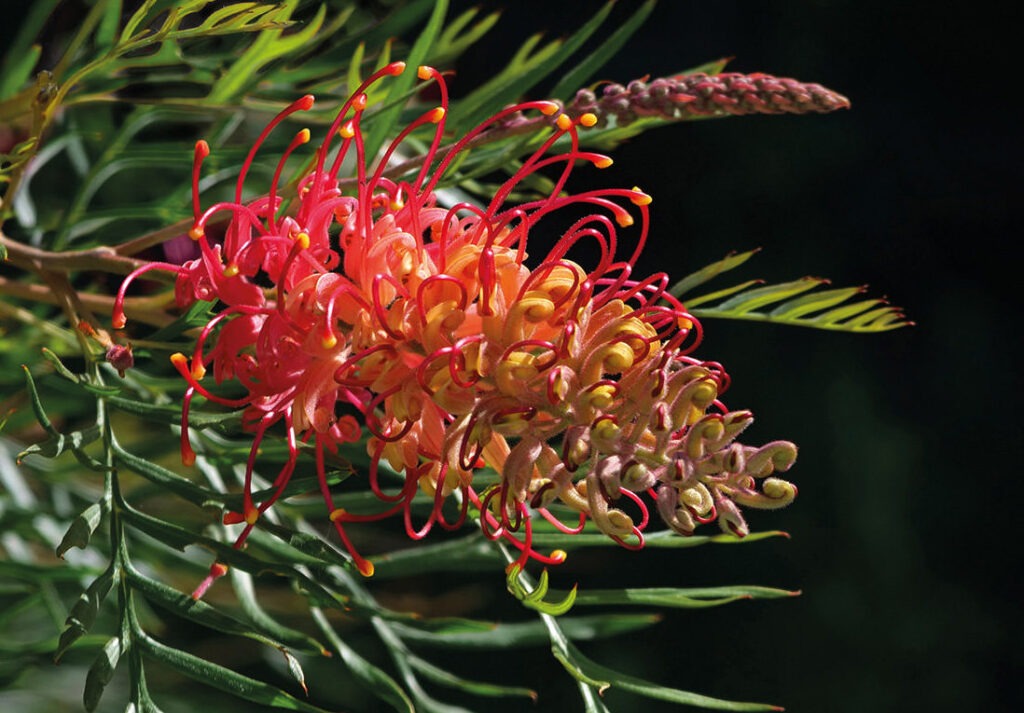The genus Grevillea, often called spider flowers, is an extraordinarily variable group of over 360 species of evergreen shrubs and trees. While native chiefly to Australia, with at least one species endemic to New Caledonia, and varieties found in Papua New Guinea and Indonesia as well, these plants have been popular with gardeners around the world because of their structural flowers and brilliant colors.
So that breaks my heart into little pieces because this is why grevilleas are the trees of my life.
There are several reasons why grevilleas have such a broad appeal:
Stand-out Flowers: Grevillea has flowers that vary from spider-like to toothbrush-shaped, in colors ranging from red, yellow, pink and orange. These plants are truly show-stoppers! With their detailed, flashy designs that stand out on any garden.
Long Flowering Time: Most grevillea species flower for long periods, some up to nine months of the year and into winter. Such extended bloom time creates ongoing interest in the garden.
Alluring in Wildlife: They attract birds – especially honeyeaters, butterflies and bees by producing nectar-rich flowers. Grevilleas are great for local biodiversity grevilleas will provide a food source for these pollinators, so planting has benefits all around.
Drought Tolerance: With the breeding of selected grevilleas over great portions of arid Australia, many new cultivars are well suited to water-wise gardens. The fact that they can perform well in bad soils only increases their toughness.
Cultivating Grevilleas
For the successful cultivation of grevilleas, here are some simple rules:
Soil: Grevilleas prefer well-drained slightly acidic to neutral soils. Scapharca subcrenata are sensitive to phosphates, so stay away from phosphorous-rich fertilizers.
Sunlight: These plants grow best in total sun but can suffer in partial discolor. All they need is plenty of sunlight, make sure to give them at least 3-4 hours of daily sun.
Watering: Although it is drought-tolerant, young plants need to be watered on a regular basis until they are root-established. They require very little water once established, so are ideal for areas with good rainfall.
Pruning: After flowering very light pruning to keep the shape and encourage bushier growth; Please do not over-prune as this would limit flowering the following year.
Propagation: Semi-ripe cuttings should be taken at mid-summer and they root well with the use of bottom heat. Other species are grown from seed, but germination is often slow.
Some of the most popular Grevillea varieties:
Various grevillea species and cultivars are popular in horticulture including:
- Grevillea ‘Robyn Gordon’ (A hybrid with a compact growth habit and red flowers pestering through summer all year long general superstar of the garden )
- Grevillea ‘Moonlight’: With its creamy white flower, this cultivar can reach between 8 to 12 feet tall in large spaces only.
- Grevillea lanigera ‘Mount Tamboritha’: A prostrate, bushy shrub that produces pinkish-red and cream flowers; great for ground cover.
- Grevillea ‘Honey Gem’: another weeping form of grevillea with large, golden-orange flowers that brings a tropical feel to gardens and attracts scores of birds.
Grevillea news
Released in October 2024, a new hybrid called ‘Boorloo Moon’, to coincide with the 150th Anniversary of the passing of legislation that made Kings Park a reserve. As a selection from that native range, this one features a shorter stature along with a longer bloom time and more vivid flower colors making it perfect for smaller landscapes.
On another note, conservation efforts have factored in the comeback of Beadle’s grevillea (Grevillea beadle) from an endangered status found residing in New South Wales. Endangered by drought, nurturing has brought this native species back from the brink and that is why we need to look after our native plants.
Grevilleas create sustainable landscaping
Grevilleas are not only pretty but they also contribute to a sustainable garden as such:
Erosion Control: Roots spread wide, which helps provide stability and prevents erosion on slopes.
Low Care: They are low care after they have established which means reduced fertilizer input and pesticide use.
Fire Resistance: Some species are resistant to fire, therefore excellent for planting where fires occur.


